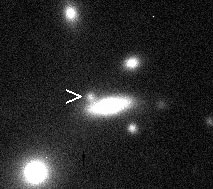NGC 5177
Appearance
| NGC 5177 | |
|---|---|
 NGC 5177 with SN 2010cr May 19, 2010 | |
| Observation data (J2000 epoch) | |
| Constellation | Virgo |
| Right ascension | 13h 29m 24.2s[1] |
| Declination | +11° 47′ 49″[1] |
| Redshift | 0.021570[1] |
| Heliocentric radial velocity | 6467 ± 29 km/s[1] |
| Distance | 297 Mly (Light Travel-Time)[1] (redshift-based) |
| Apparent magnitude (V) | 15.1g[1] |
| Characteristics | |
| Type | S0[1] |
| Apparent size (V) | 0.81' x 0.46'[1] |
| Other designations | |
| MCG +02-34-019, PGC 47337[2] | |
NGC 5177 is a lenticular galaxy. Based on a redshift of 6467 km/s the galaxy is crudely estimated to be about 300 million light-years away.[1]
On April 16, 2010 UT, the Palomar Transient Factory automated wide-field survey detected a supernova on the outskirts of NGC 5177.[3] The supernova is known as SN 2010cr[4] and is located at 13:29:25.11 +11:47:46.4.[3] A confirmation spectrum was taken with the Palomar Hale Telescope on April 17 UT which showed it to be approximately 13 days before peak brightness.[3] The Hubble Space Telescope took STIS/UV spectroscopic observations on May 3, 2010.[5]
Gallery
[edit]-
NGC 5177 with SDSS
See also
[edit]- List of supernovae
- History of supernova observation
- List of supernova remnants
- List of supernova candidates
References
[edit]- ^ a b c d e f g h i "NASA/IPAC Extragalactic Database". Results for NGC 5177. Retrieved 2010-05-19.
- ^ "NGC 5177". SIMBAD. Centre de données astronomiques de Strasbourg. Retrieved 2021-02-19.
- ^ a b c "Nearby supernova, PTF10fps". The Astronomer's Telegram. 2010-04-22. Retrieved 2010-05-19.
- ^ "List of Supernovae". Central Bureau for Astronomical Telegrams. Retrieved 2011-07-03.
- ^ Richard S. Ellis (2010-05-03). "HST Preview for OBD708010". [Hubble Legacy Archive]. Retrieved 2010-05-19.
External links
[edit]Wikimedia Commons has media related to NGC 5177.
- NGC 5177 on WikiSky: DSS2, SDSS, GALEX, IRAS, Hydrogen α, X-Ray, Astrophoto, Sky Map, Articles and images


